Anycubic has been a household name in the 3D printing scene since the successful Anycubic i3 Mega . The Anycubic Kobra also mostly received a positive response. Now the manufacturer is bringing out the successor, the Anycubic Kobra 2 – and it’s supposed to be faster and more user-friendly . Is that correct? We will find out together in the CG test.
- Anycubic Cobra 2 3D-Drucker
Anycubic Kobra 2 Review & Specs
- Specifications: 2 major upgrades
| Manufacturer | Model | Anycubic | Cobra 2 |
| design type | i3 |
| printing technology | FDM (Direct Drive) |
| print speed | max. 250 mm/s (Standard 150mm/s) |
| installation space | 220 x 220 x 250 mm |
| print bed | heatable (up to 110 degrees) |
| max. Nozzle temperature | 260 Grad |
| nozzle diameter | 0.4mm |
| connectivity | Micro SD, USB-C |
| Features | fully automatic auto-leveling (25 points) Direct Drive (4:1) PEI-Federstahlplatte 4.3 inch touch screen 32Bit Motherboard mit TMC2209 Dual Z-axis (belt connected) Filament sensor Powerloss-Recovery Belt tensioner x/y |
| overall dimension | Weight | 440 x 435 x 486 mm | 8,4 kg |
Scope of delivery: three parts instead of two
There she is again. One of those ominous brown boxes that it’s supposed to be in: the second generation plastic-melting cobra. Of course, it doesn’t meander out of the box on its own – so let’s unpack now.
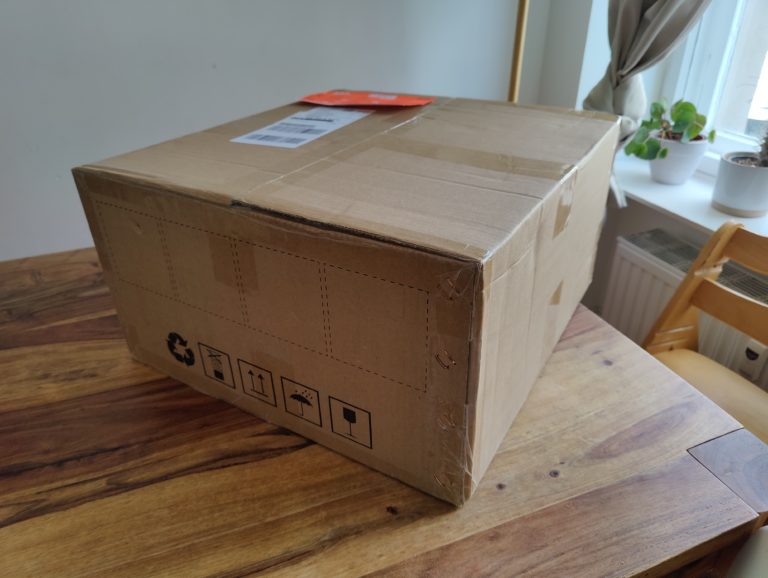
First of all, the PEI spring steel plate strikes me positively, underneath, as usual, there is a 3D printer perfectly protected by foam , which, however, comes in 3 parts: base, frame and print head.
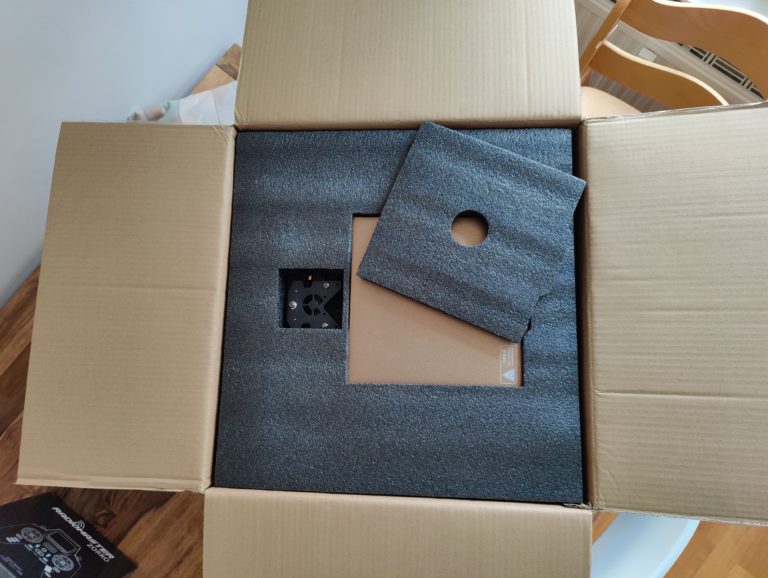
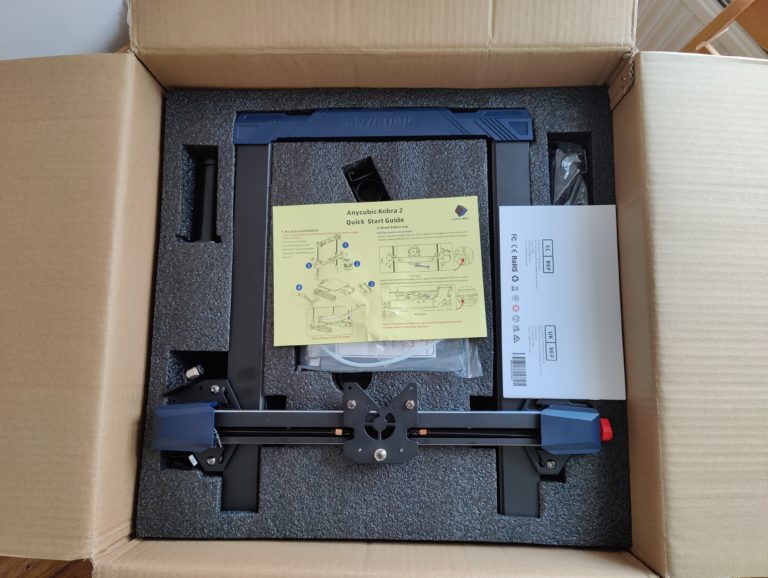
In addition to the 4.3-inch touch display, there is also the usual tool including a replacement nozzle, micro SD card and USB stick. Apparently savings are made with the filament, because there are only 10 meters of it in gray. In any case, this applies to the standard scope of delivery. To be fair, Anycubic sent us two 1kg spools of gray PLA filament separately.
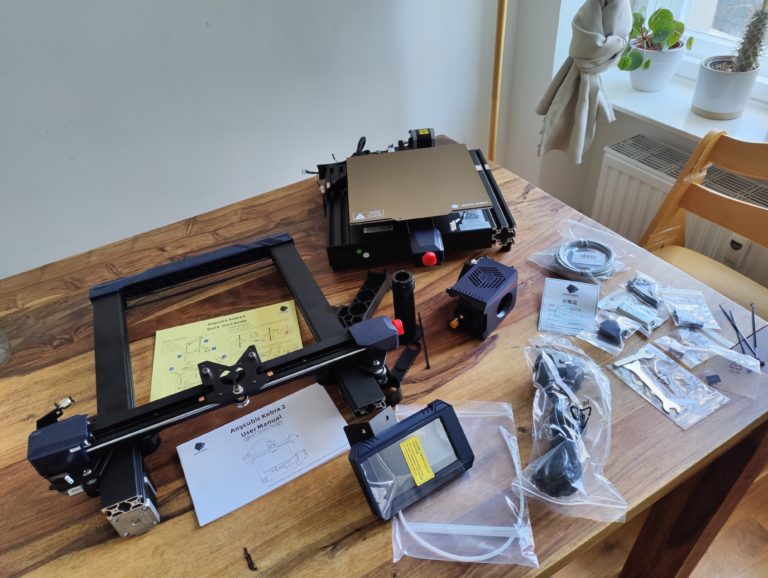
Design: typical Anycubic
The Anycubic Kobra 2 measures 440 x 435 x 486 mm and weighs only 8.4 kg in the classic i3 format. The installation space is 220 x 220 x 250 mm. Black aluminum profiles are combined with manufacturer-typical dark blue plastic panels.
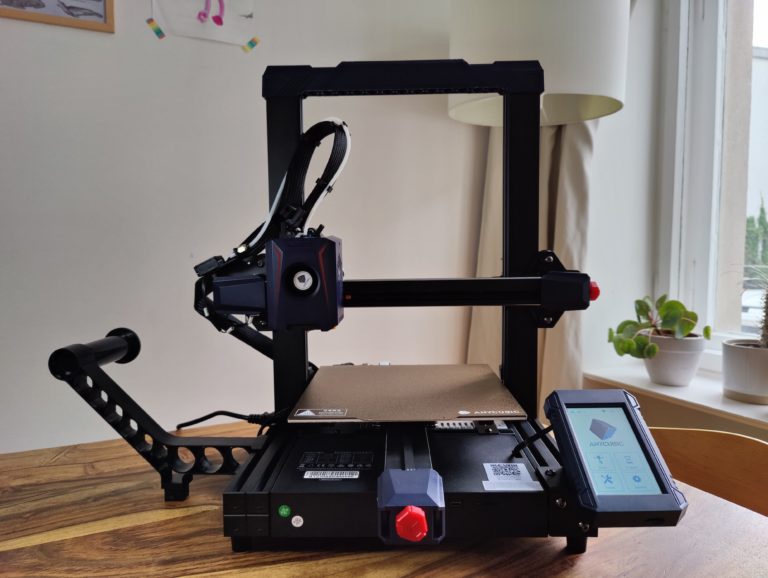
The bright red buttons on the x and y belt tensioners are eye-catchers. Such red accents can also be found on the print head including the direct-drive extruder with a 4:1 ratio.
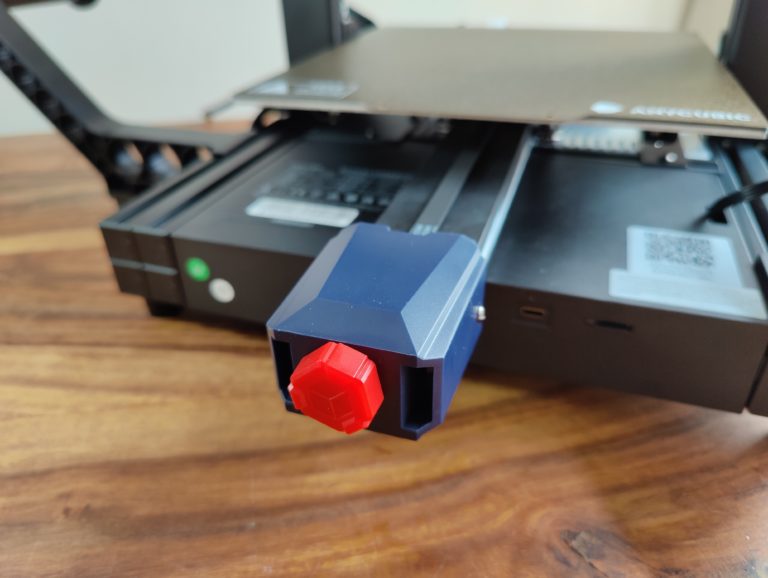
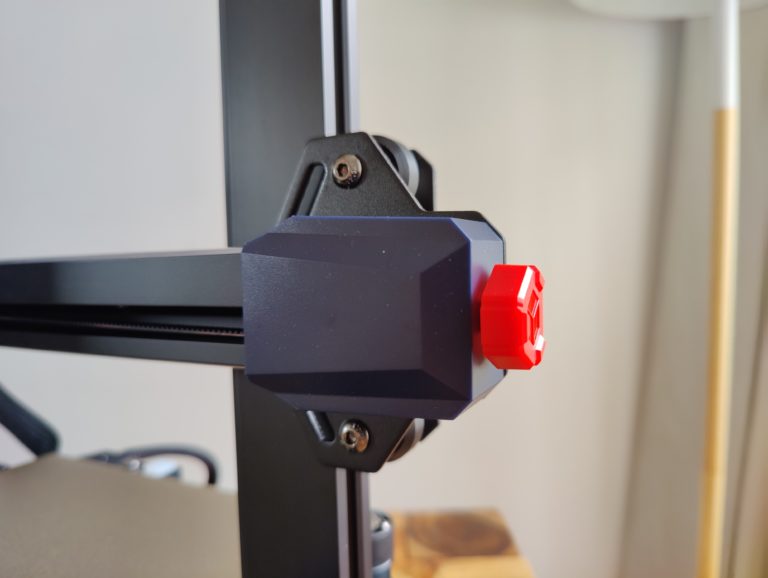
I like the design very much – except for the fan duct of the component cooling, which could have been aligned even more closely with the nozzle, which can be heated up to a maximum of 260 degrees.
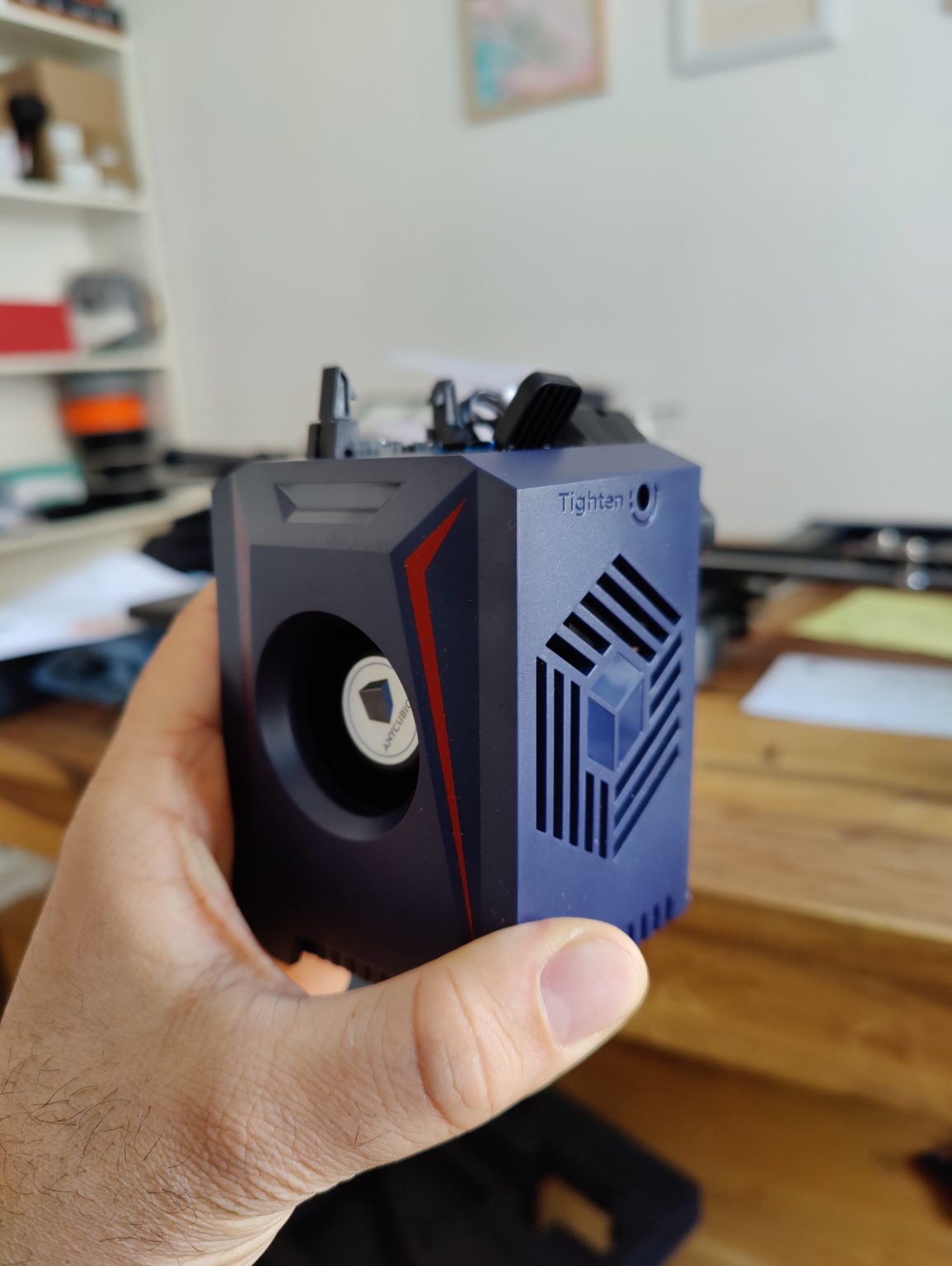
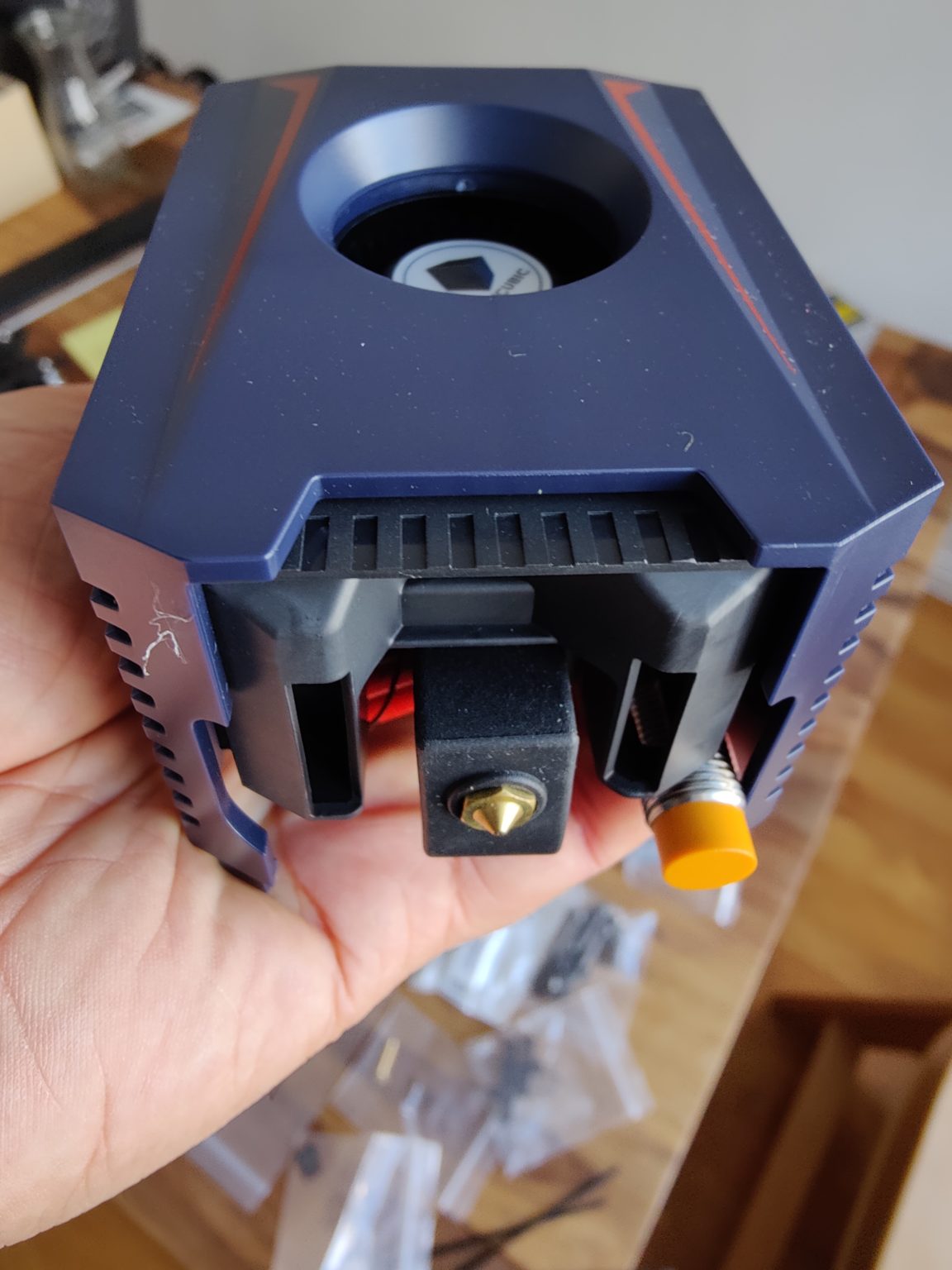
What’s striking about the printhead is the large inductive sensor that’s part of Anycubic’s new fully automated leveling called LeviQ 2.0, which we’ll get to.
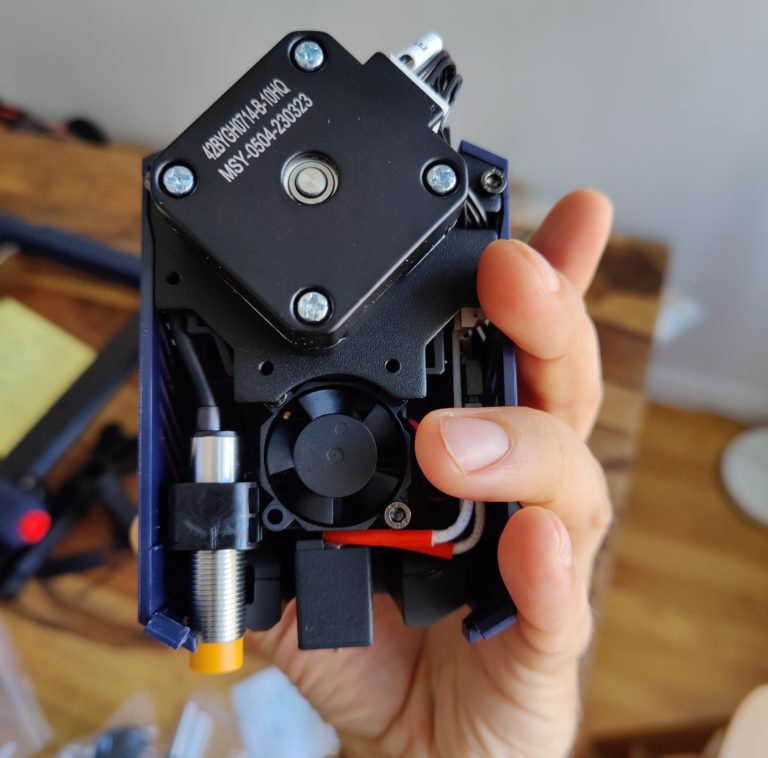
Fortunately, Anycubic uses two Z-axes for the Kobra 2, which are connected to each other by straps below the upper cross brace.
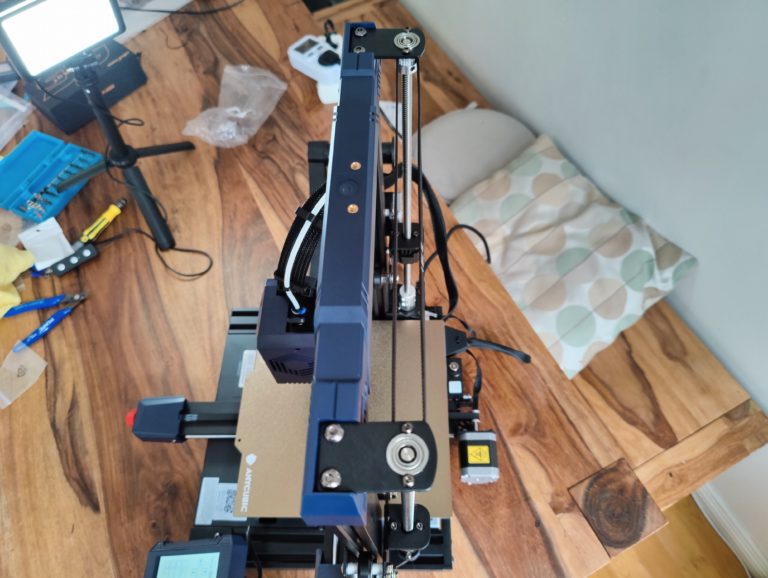
Also new are a small white silicone block intended as a scraping aid and a “ trigger switch ” (metal print head) for automatically setting the Z offset during auto-leveling. Both are located at the back of the 220 x 220 mm hot bed, which can be heated up to a maximum of 110 degrees.
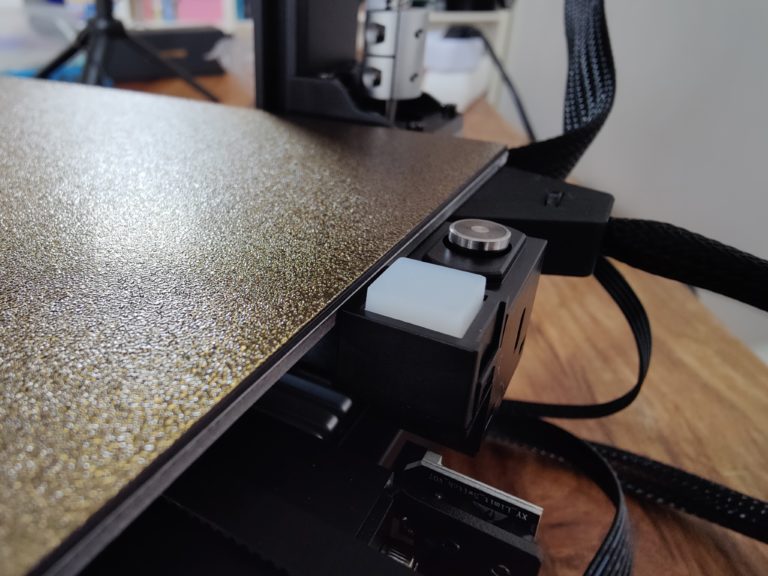
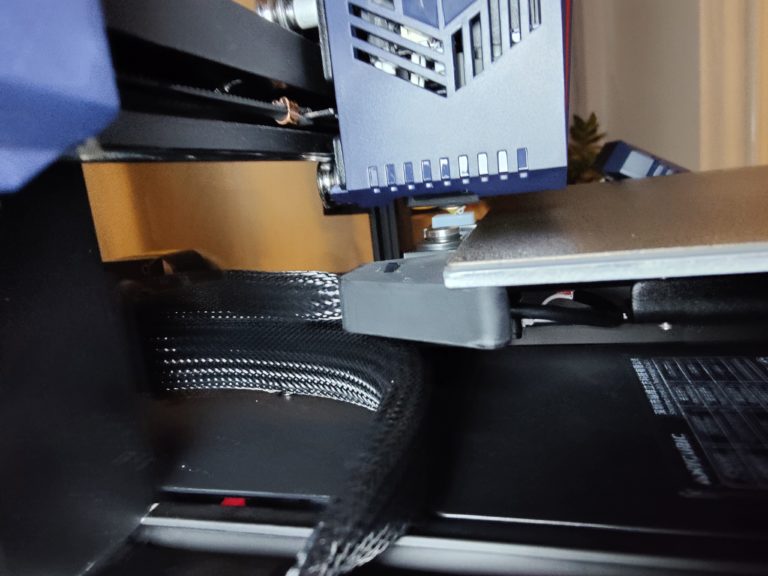
Another innovation concerns the suspension of the X and Y slides : instead of rubber rollers, Anycubic uses SG15 U-groove bearings made entirely of metal and correspondingly curved metal rails . metal on metal? Sounds strange, but the manufacturer is talking about a smoother and less wear-resistant variant.
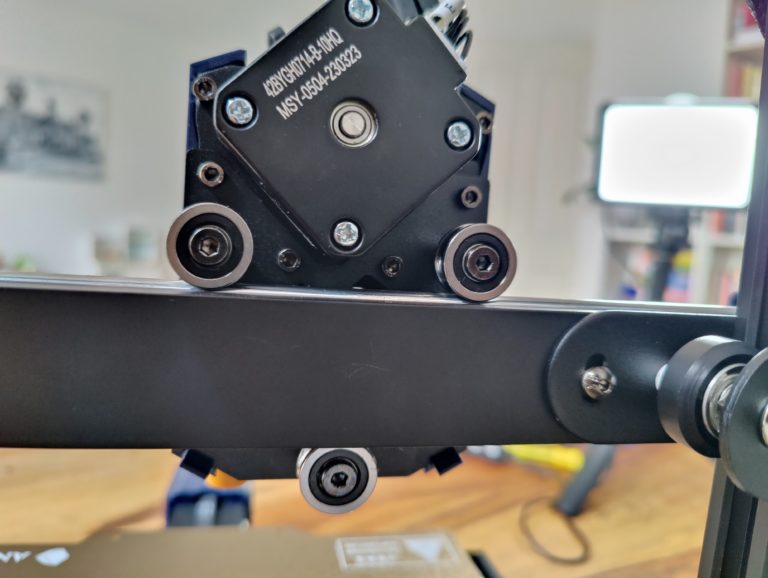
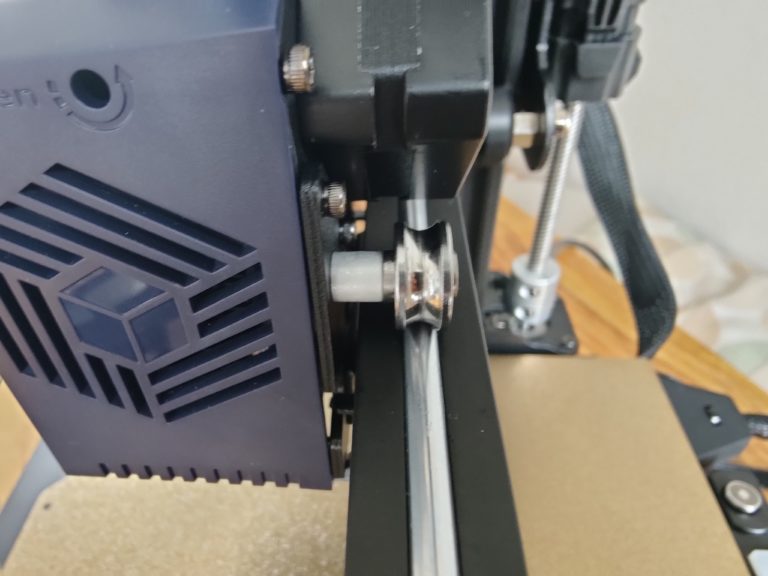
Construction: easy
Before I start the actual construction, I take a look at the inner workings of the printer base as usual. At first glance, everything looks cleanly wired and laid out neatly. The TMC2209 stepper drivers on the 32-bit board are soldered, the printer is grounded. So far so good.
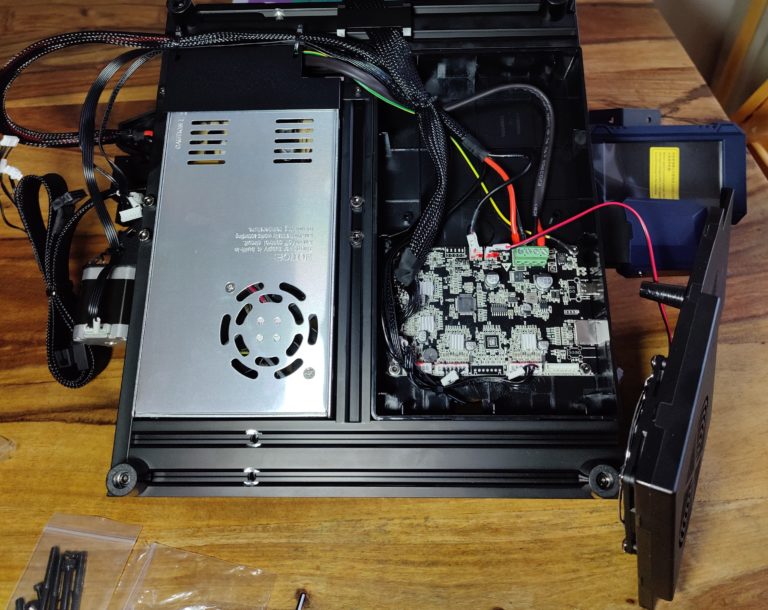
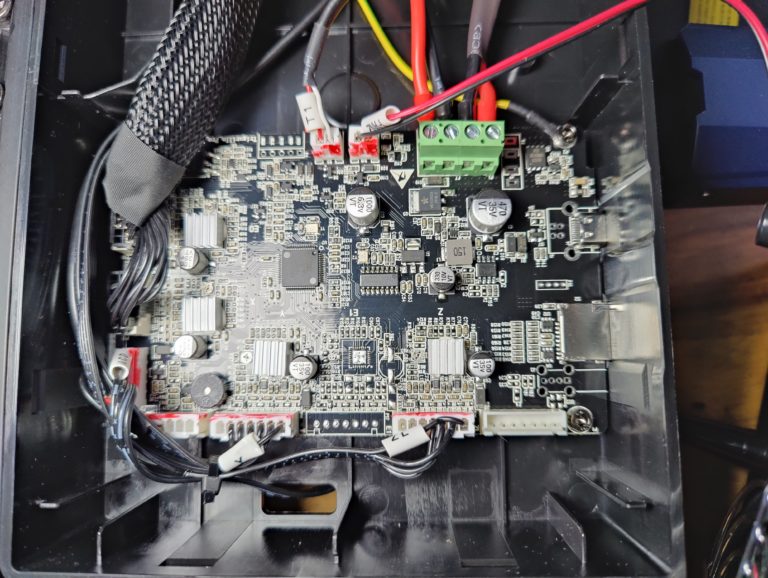
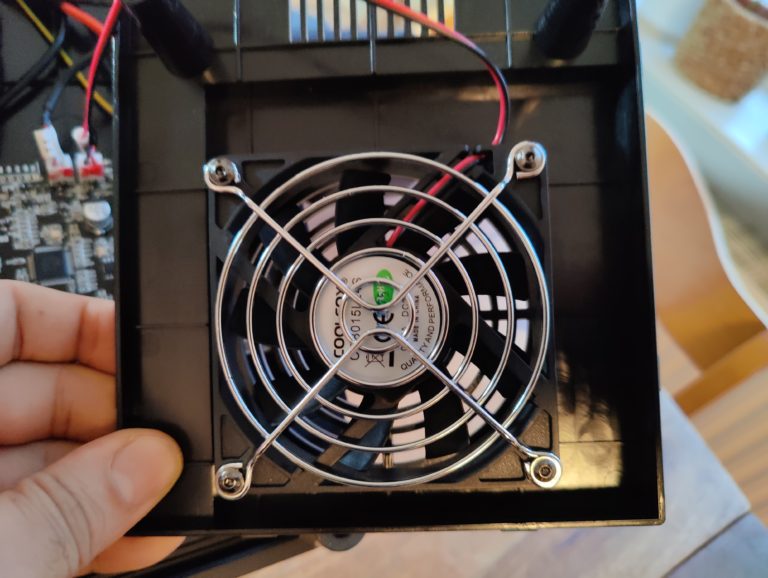
As a curiosity nose, which I am, I also look at the power plugs, which are crimped, but at the same time tinned. This is not ideal, since soldering tin is actually not used when crimping.
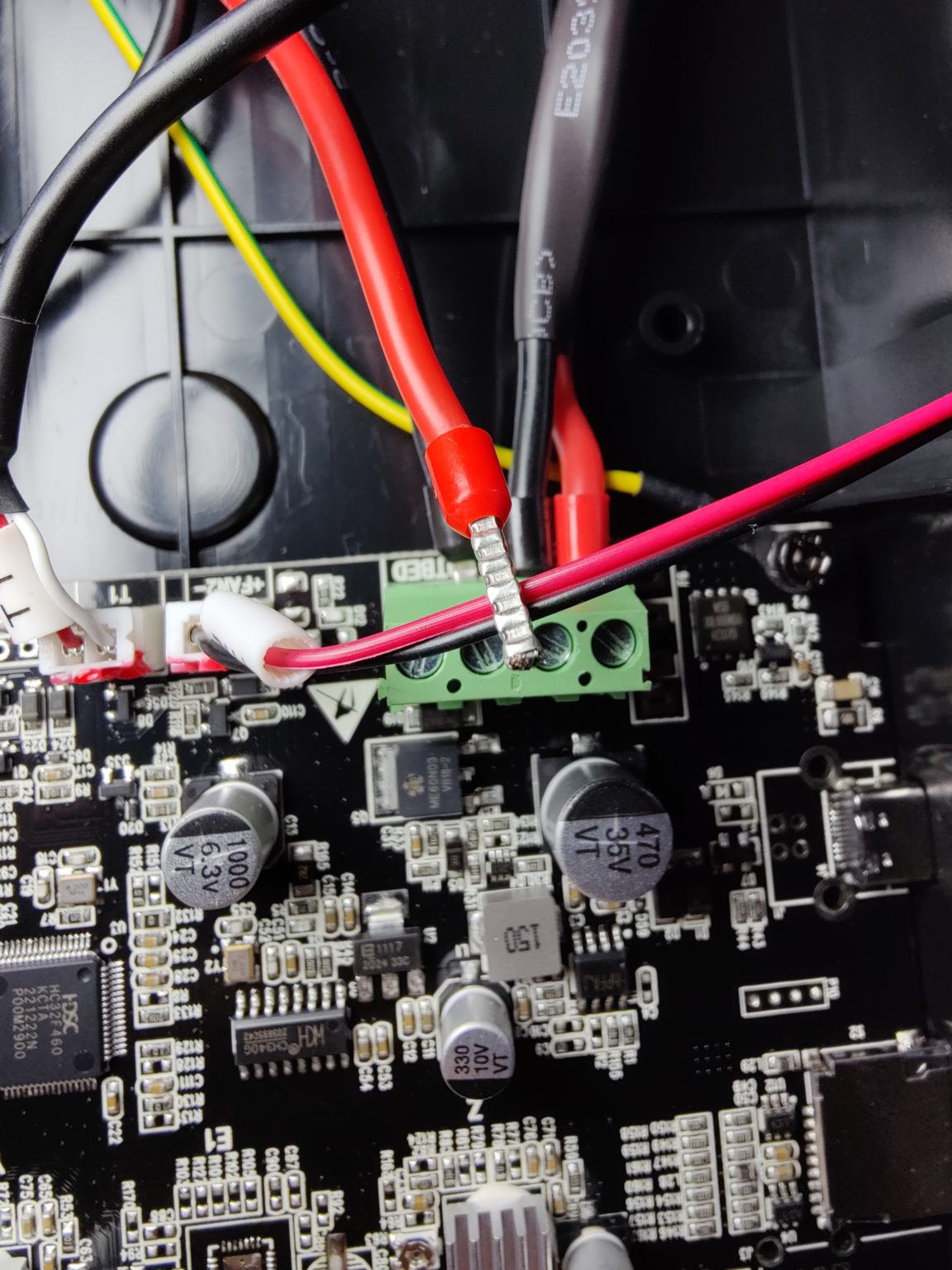
I’m about to turn the base of the Kobra 2 around when I notice the unfortunately somewhat uncleanly soldered power cable on the heating bed. Strain relief or not: At this point, unclean soldering points simply do not inspire confidence, but they are good.
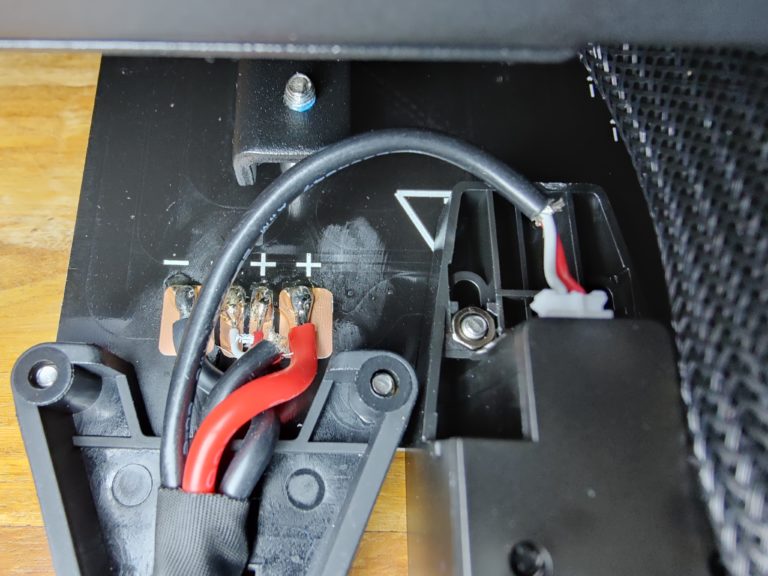
So now it’s time for the actual construction. And that’s done quickly: a few screws that connect the frame to the base, plus a few screws to attach the print head to the X-carriage and the touchscreen to the base – done. Well, okay, almost done. The filament sensor still needs to be installed just like the PTFE tube.
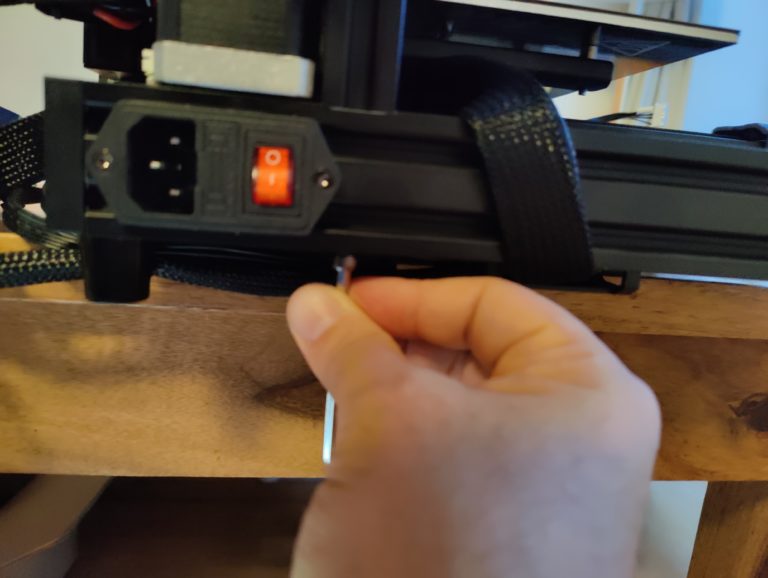
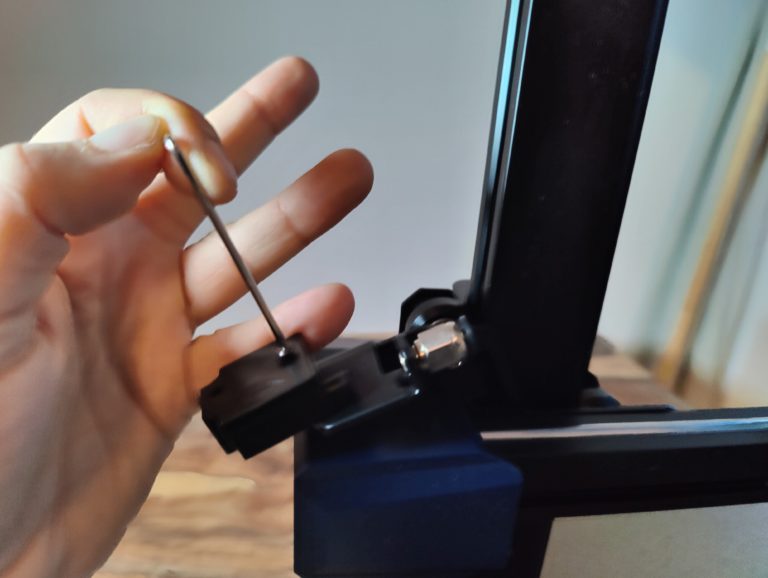
Now I connect all the exemplary labeled plugs with their corresponding sockets and fasten the filament holder on the left side. “Attach” means ” clamp” here, which I find a bit strange – because the filament holder is quite wobbly.
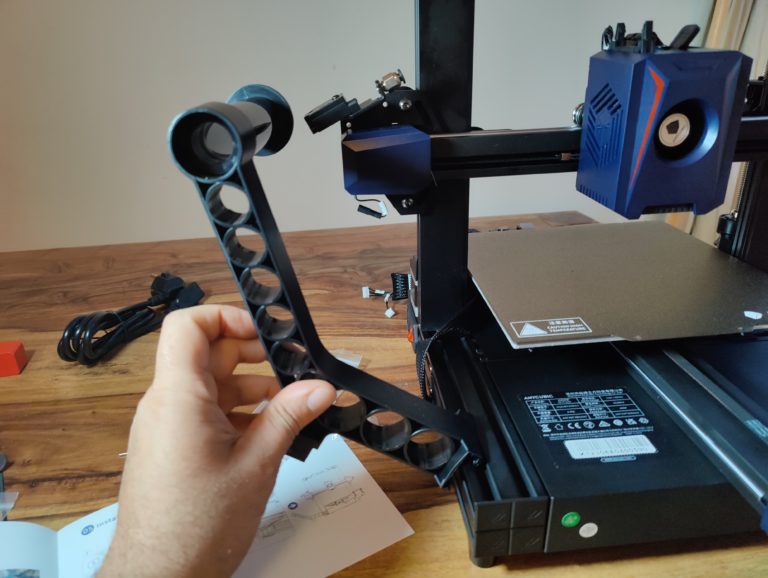
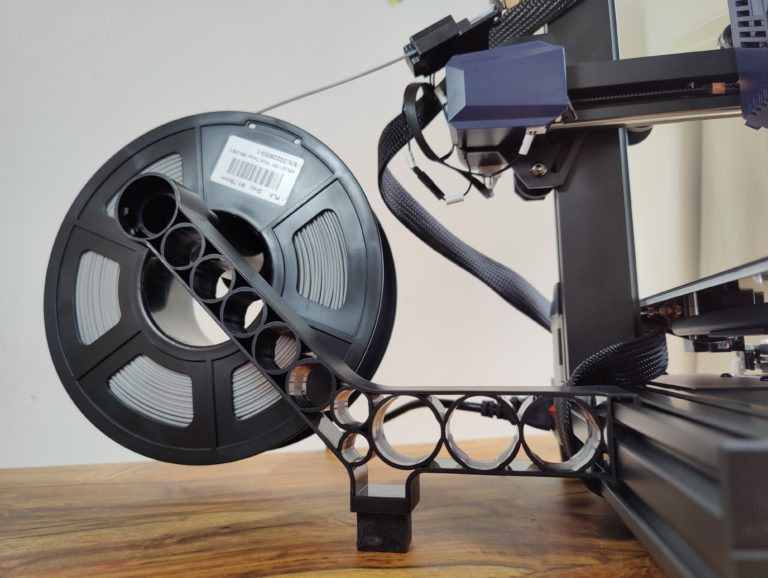
The connection of the sleeved flat cable at the top of the printhead deserves special praise. It is not only held in position with two hooks on the sides, but also protected with a plastic cap that also functions as a cable guide – clever. Smaller plastic clips hold PTFE tubing and ribbon cable in place.
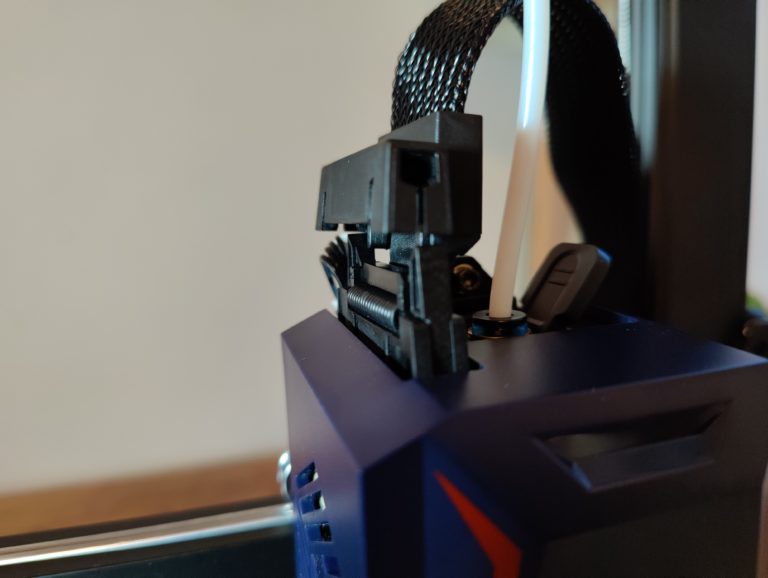
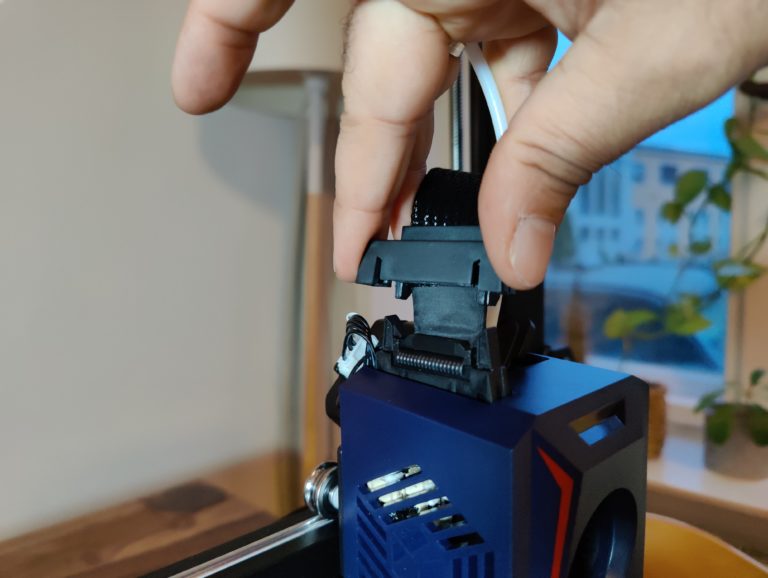
Commissioning: easy up 2
Sentimental feelings about my old Mega-S come up when I hear the typical Anycubic start-up melody when switching on the printer. Unfortunately, the fan in the printer base runs right from the start.
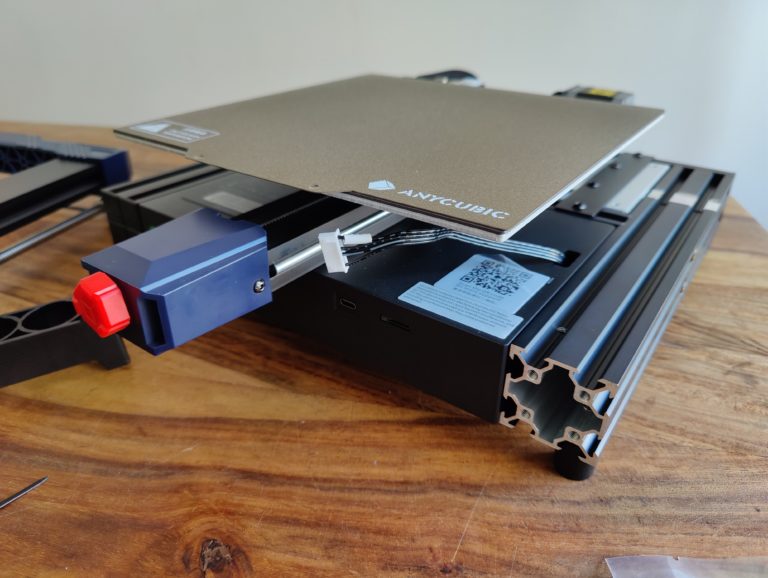
The menu navigation of the touchscreen is intuitive and quite spartan. The temperatures for the heating bed and nozzle can be seen at the top left and right, otherwise there are 4 central menus (Print, Prepare, Tools, System).
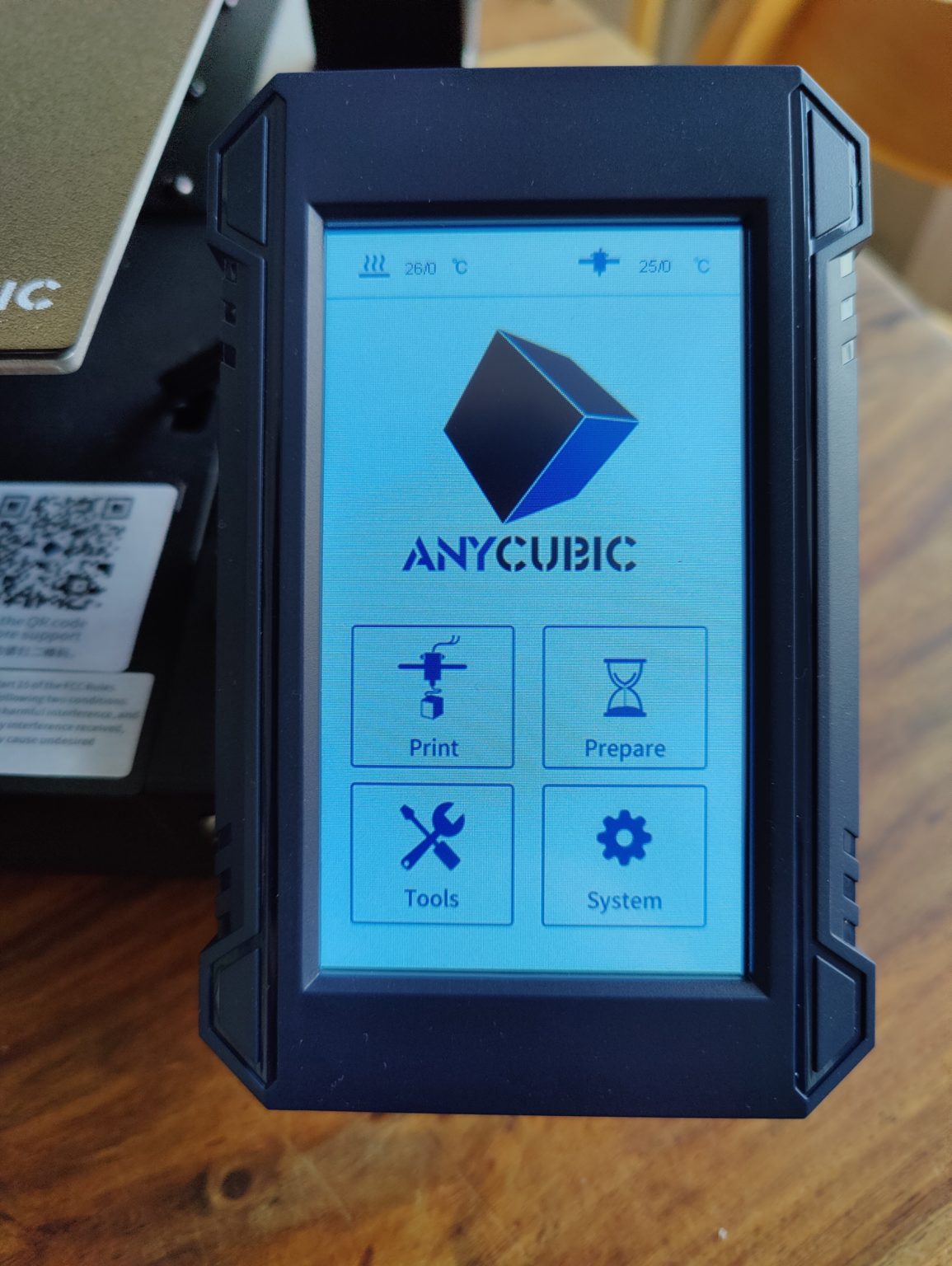
While “Print” displays the print files on the SD card, “Prepare” contains the options for leveling, preheating and filament loading and unloading. “Tools” includes manual axis, temperature and speed control as well as switching off the motors. In addition to information about the firmware and deactivating the start-up melody, under “System” you also have the option of switching to Chinese.
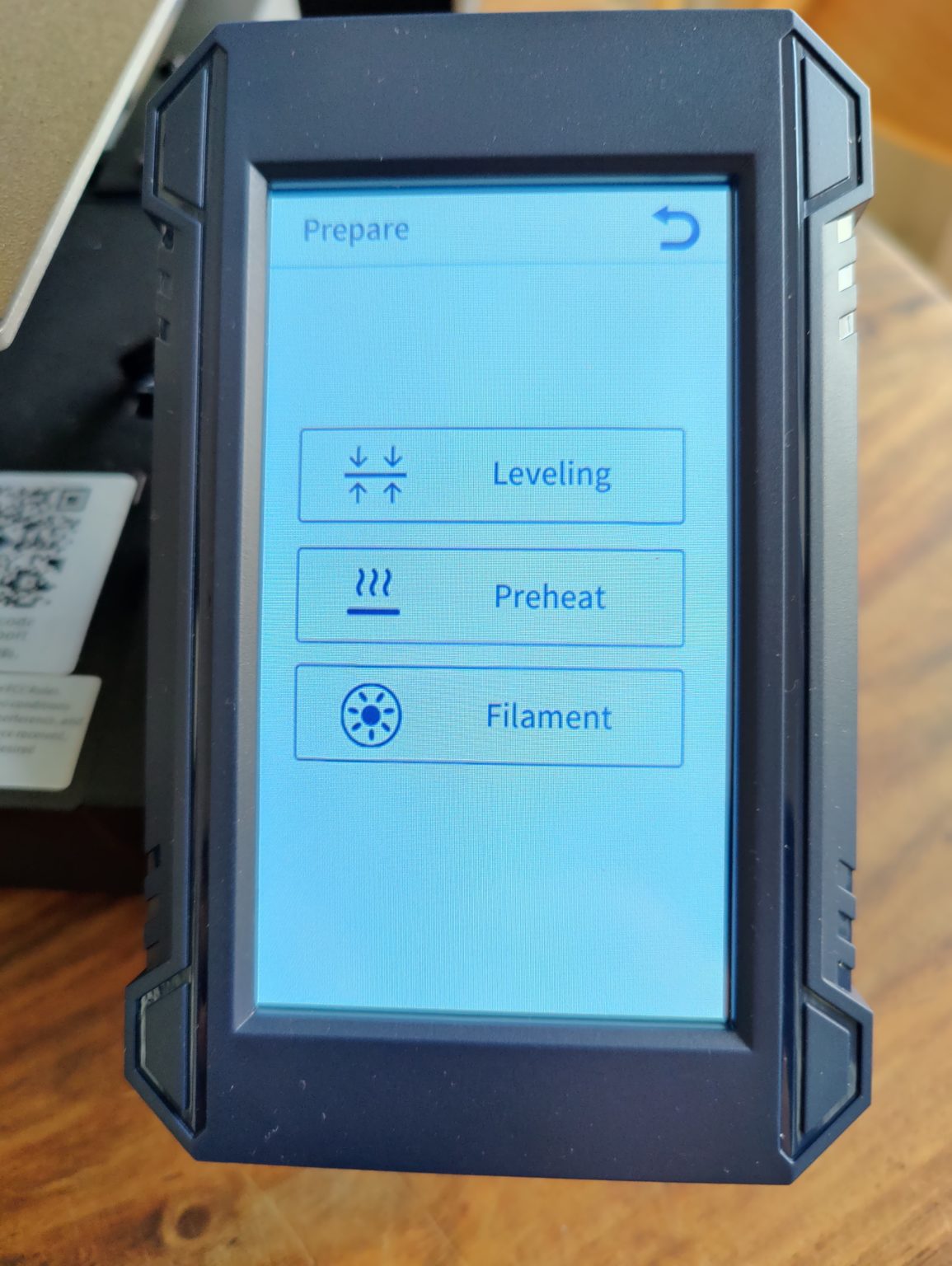
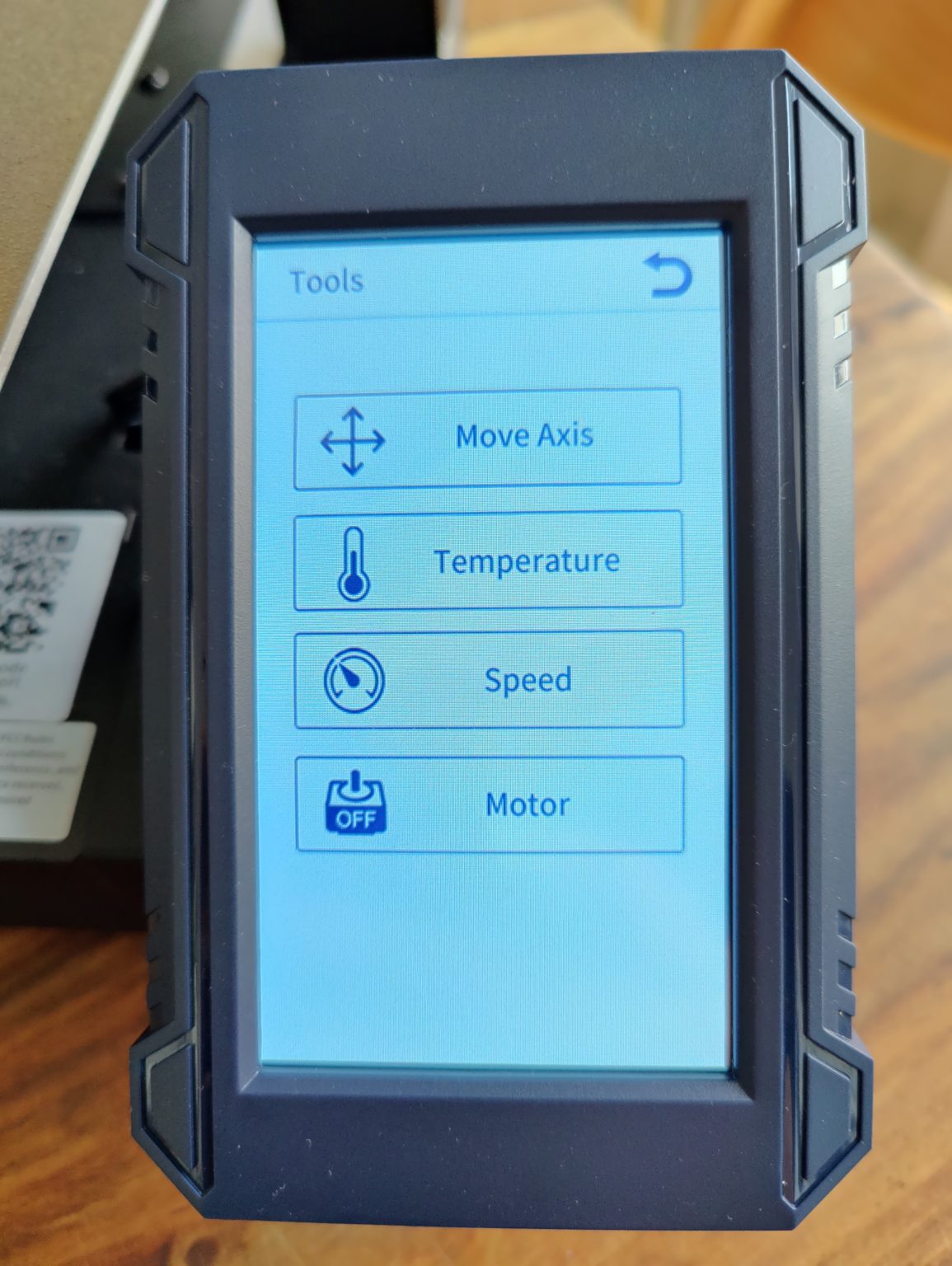
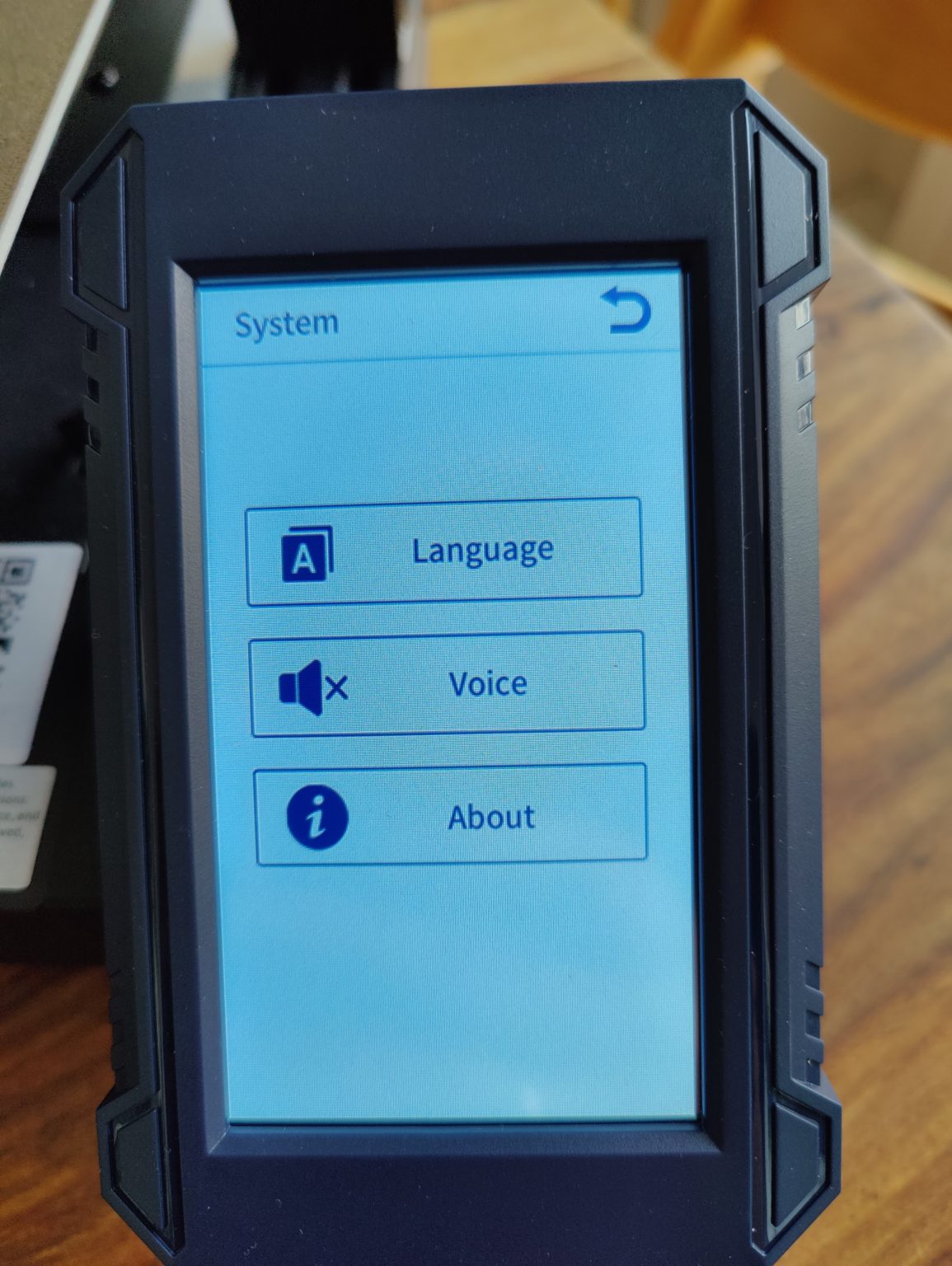
First of all, I select auto-leveling under “Prepare” . And that happens fully automatically thanks to Anycubic’s LeviQ 2.0: first the print bed and nozzle heat up, Anycubic has thought a lot about this. Then the print head moves over the print bed at the front left and extrudes filament. The nozzle now touches the PEI spring steel plate twice before the print head moves backwards quickly and moves back and forth twice over a square white silicone pad. He then lingers on the silicon block.
Does auto-leveling start now? Not quite yet: First, a “trigger switch” is activated twice by the pressure nozzle. Since this switch – a metal surface – is at roughly the same height as the print bed overlay, this should give the Z offset value. Only then does the 25-point autoleveling start, in which neither the nozzle nor the inductive sensor touch the print bed surface.
Anycubic’s LeviQ 2.0 is not free of weaknesses. Two points stand out here: First: Almost always a strip of filament remains after extruding material on the PEI sheet . The silicone block is supposed to act as a wiping aid – but you don’t see anything of that at all. I also don’t understand why the nozzle stays on the block for a long time.
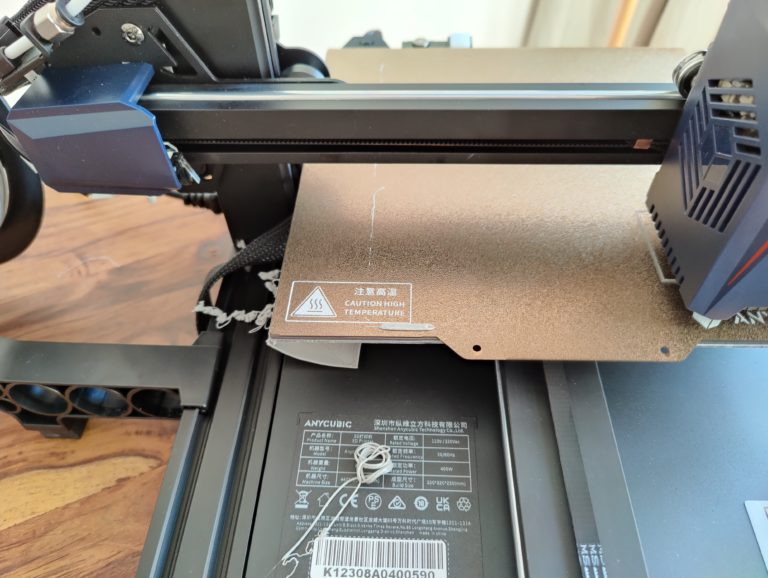
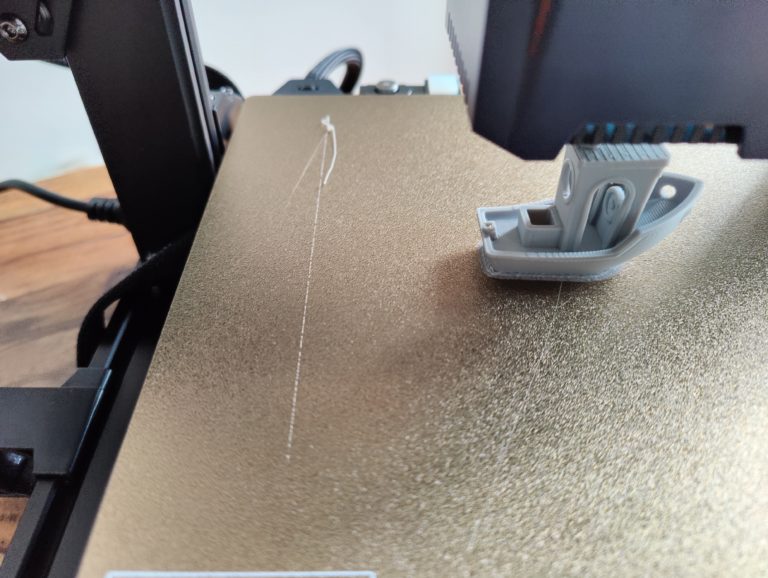
Second point: The trigger switch as a reference for the Z offset did not work accurately enough for me: the nozzle was too far away from the heatbed. With the help of a leveling test, I then manually adjusted the Z offset value via the touch display. Except for these shortcomings, everything else worked wonderfully.
Emissions: Hunger for electricity – volume – heat
The printing Kobra of the second generation treats itself to 8.6 W when idling after switching on. When the print bed is heated to 60 degrees, it is then 298.6 W on average. If you then add the hotend with a target temperature of 195 degrees, we have an average of 159.8 W. When actually printing (60 degrees heating bed, 186 degrees hotend), the Anycubic Kobra 2 is on average with 163.2 W.
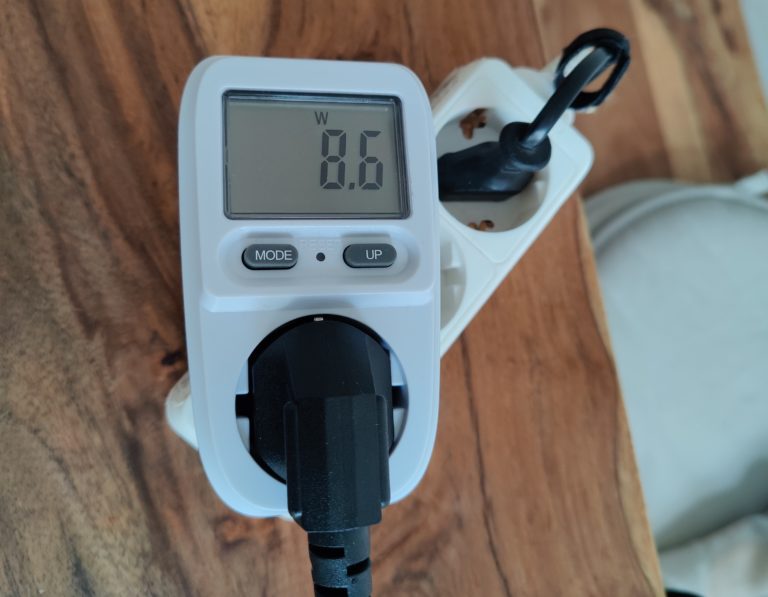
For comparison: The AnkerMake M5 we tested – at that time also running at a maximum of 250mm/s – had an average of 274.8 W when heating up the bed and nozzle and 147.3 W when printing. Compared to the other printers we tested, the power consumption here is rather in the upper range, with the exception of idle operation.
As far as the volume is concerned, the fan in the base of the printer starts up as soon as the printer is switched on, but it still whispers tolerably at an average of 56 dB.
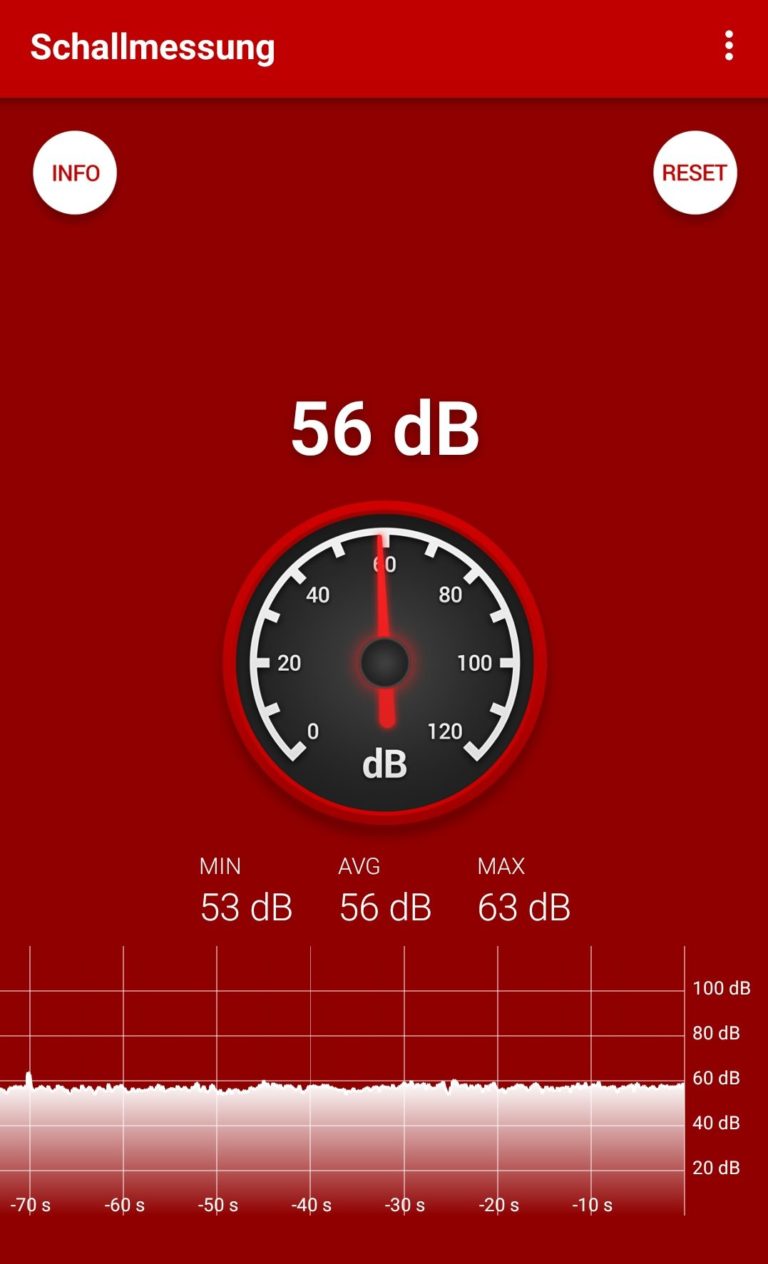
That changes as soon as the quite potent individual component fan comes into play during printing. Anycubic is talking about a 4-Watt fan that achieves 7000 revolutions per minute. You can hear that. And with an average of 70dB much too violent. Anycubic? Sorry, that’s too loud for 150mm/s standard speed.
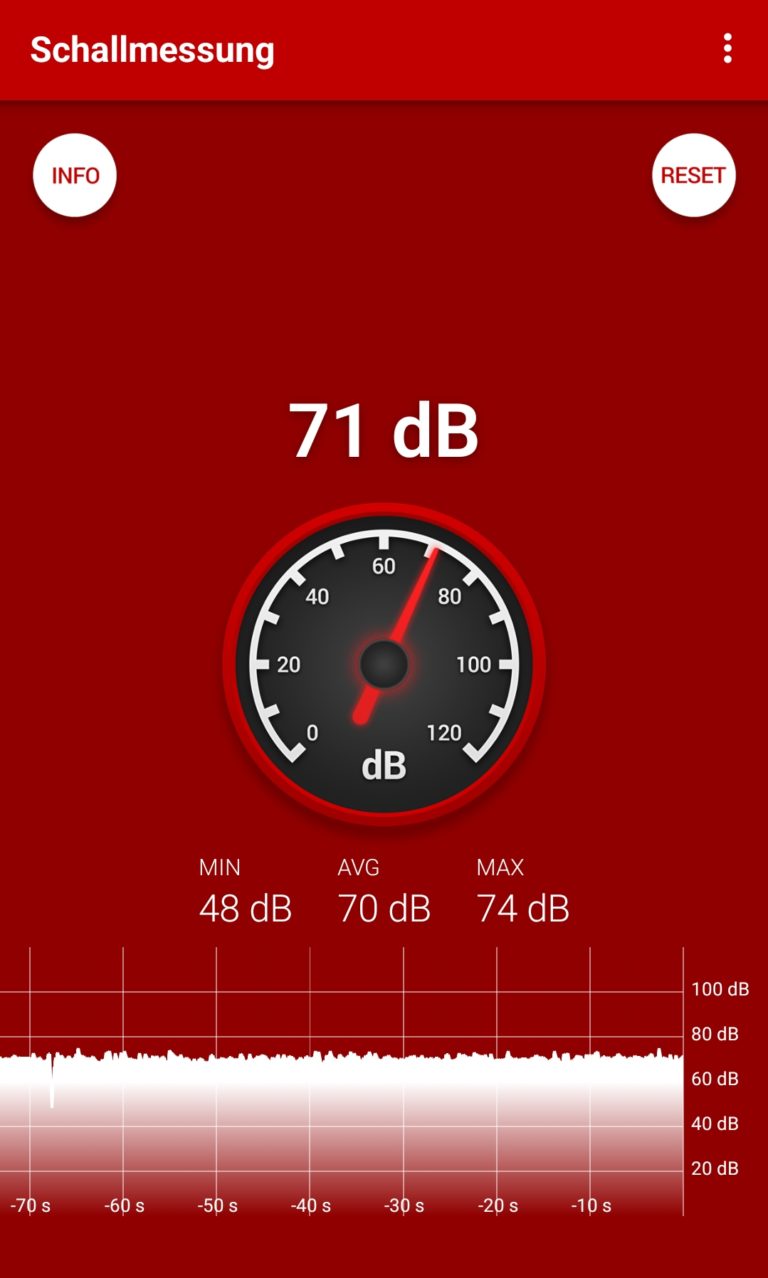
As is so often the case, the heat distribution on the printing bed is not very homogeneous. It gets warmest at the front left and in the middle of the print bed, which the FLIR image shows quite clearly. In concrete terms, this means: I measured 58.4 degrees at the front left, 56.8 degrees at the front right, 57 degrees at the rear right and only 53.9 degrees at the rear left. 57.3 degrees are recorded in the middle. Thanks to the textured PEI spring steel plate, I didn’t and still don’t have any adhesion problems. While all other enginesaround 36 degrees, the y-axis motor scraped pretty close to the 60 degree mark.
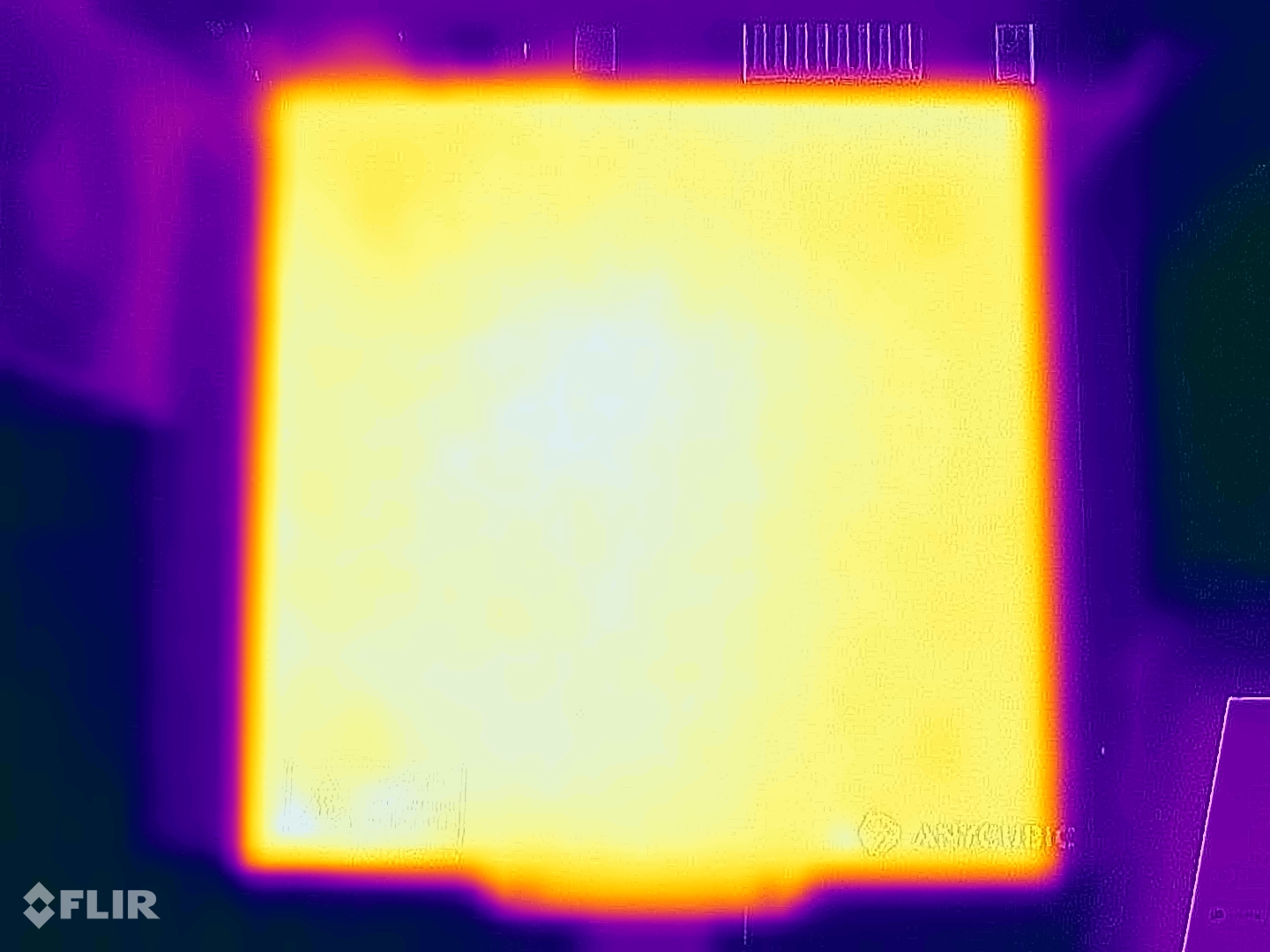
Software & print samples: good with some drawbacks
Wow, a manufacturer that supplies slicer profiles with its new printer ! So at least for the PrusaSlicer. Because there is a profile for PLA on the SD card. Anycubic also sent us a profile for Cura. However, the latter delivers a meager result with the first print of a bench (195 degree nozzle, 60 degree bed, filament: Anycubic PLA gray) at 150mm/s. One reason for sure: Anycubic forgot to set the retraction distance in Cura from 8mm to 2mm for the in-house direct drive extruder.
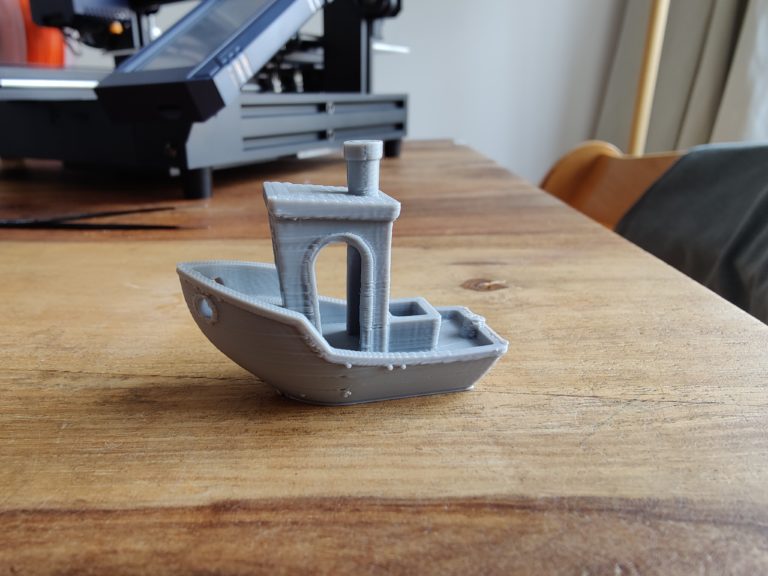
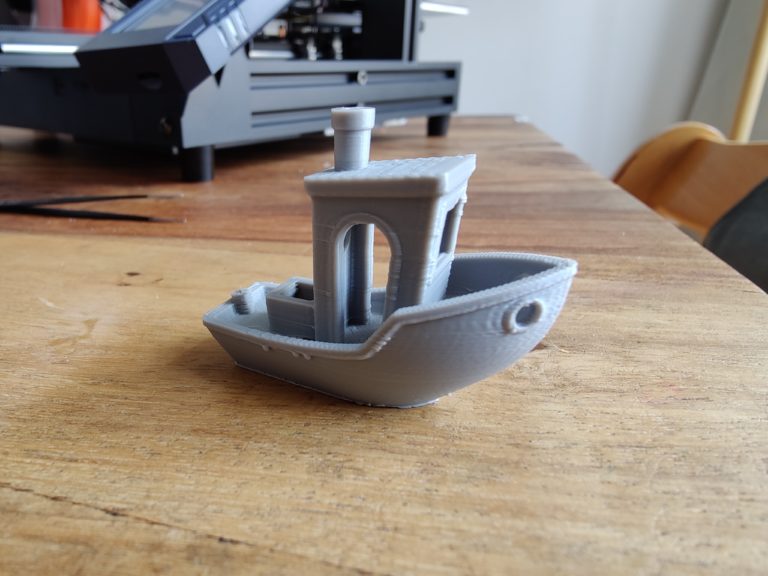
So I print the same benchy again with Anycubic’s PrusaSlicer profile. Because with exactly that, Anycubics sample prints are also generated on the SD card. Lo and behold, the Benchy comes out of the Anycubic Kobra 2 much better. Slight ghosting can be seen in the front area in particular. This shows what constitutes input shaping. Just like Linear Advance, this is not implemented on the Anycubic Kobra 2 because of the Marlin Legacy Firmware.
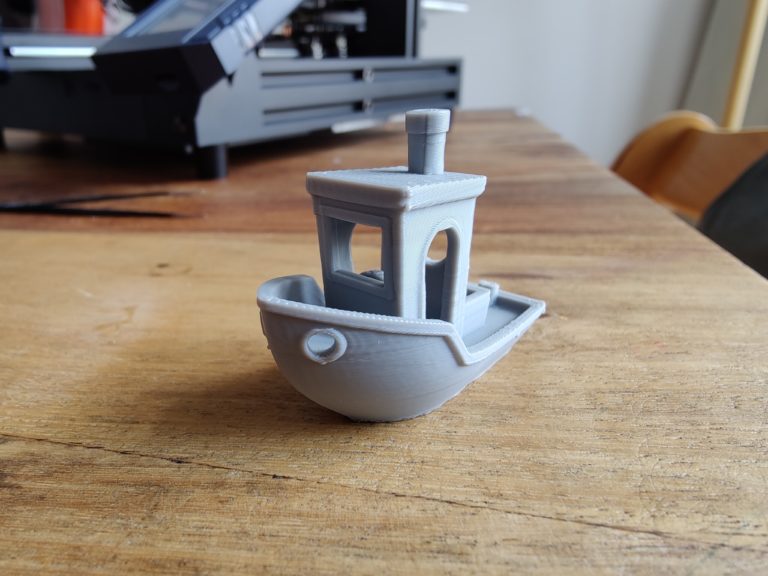
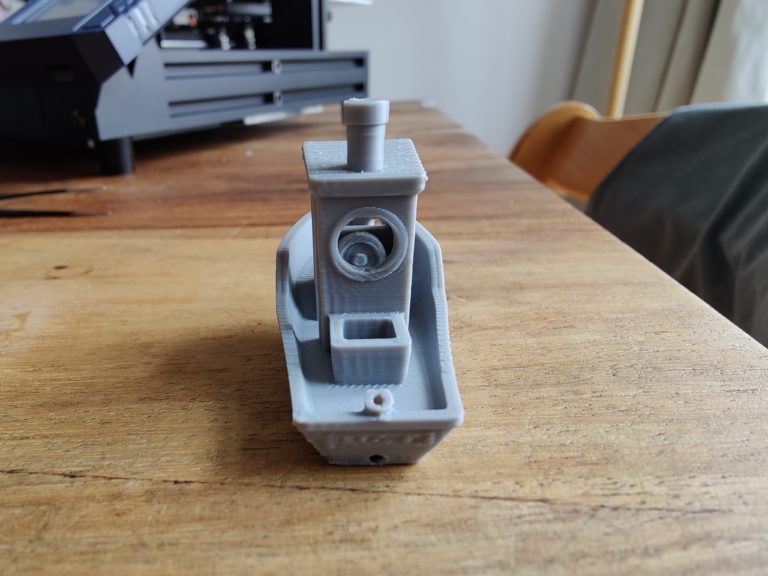
Next comes the usual Voronoi bench as a torture test. It finishes after 1h20m at 185 to 60 degrees at a print speed of 150mm/s and reveals problems with cooling on overhangs. Many of the ramifications lead nowhere. Here, for example, the Ender-5 S1 performed significantly better.
These problems are also evident in the mini-all-in-one test printed with the same parameters: the overhangs start to get messy at just 60 degrees. Uncleanliness can also be seen in the other filigree structures, as well as in the inscribed surface. On the other hand, the bridging properties are excellent.
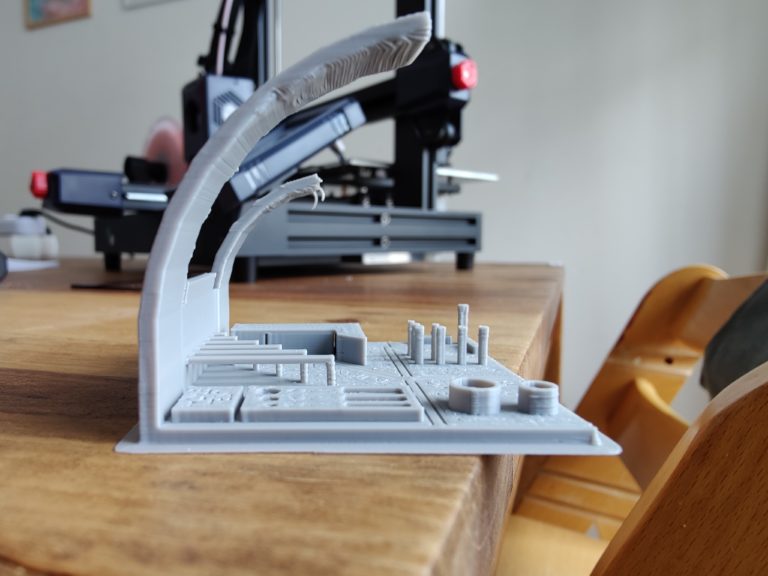
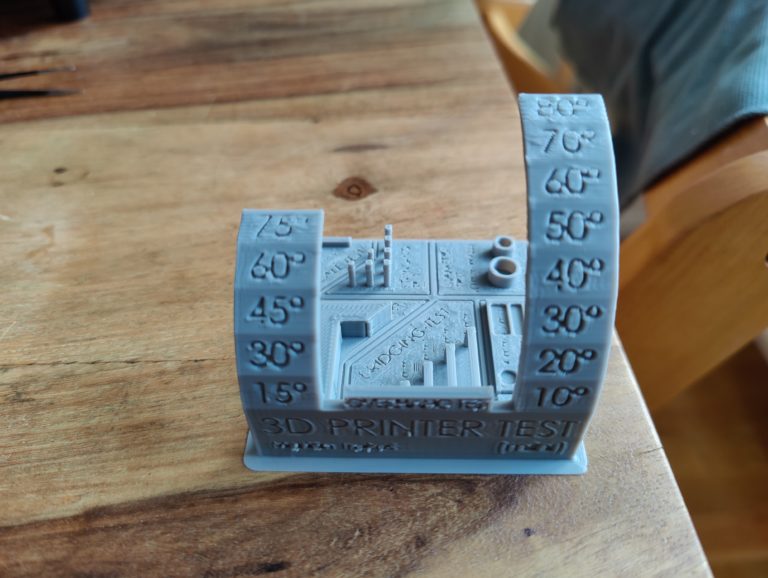
I use the Anycubics gray PLA filament again for an RC ski jump that will be used in a later hands-on. Almost the entire printing plate is filled here. The pressure is difficult for the Kobra 2 because I don’t use support below the ramp. 2x I print the ski jump. After every 7 h 20 m the print is ready. Let’s make it short: I’ve seen better prints, but it won’t detract from the functionality.
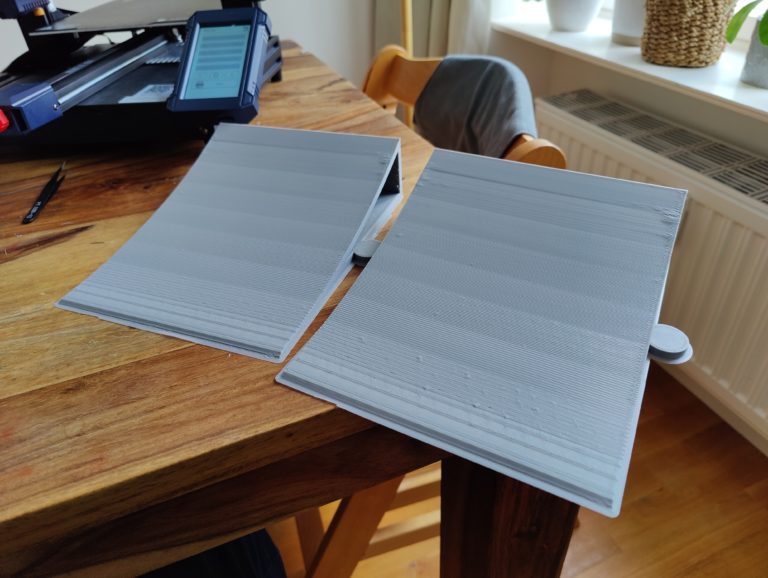
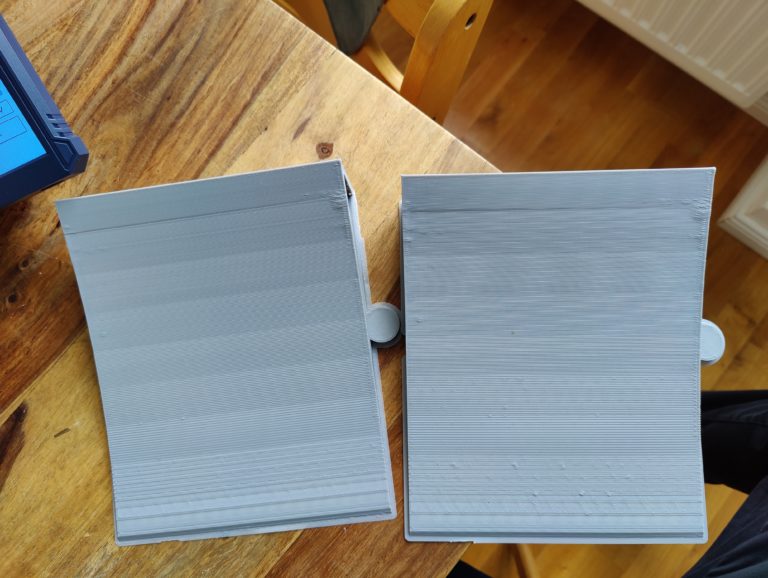
Out of curiosity, I choose a different speed mode while printing , because 3 different modes can be used in the menu: Stable (80%), Standard (100% = 150mm/s) and Sport (120%). The joy of the really fast pressure in Sport mode is short-lived: A strong vibration and creaking sounds from the Y-axis motor ensure that I quickly return to Standard mode.
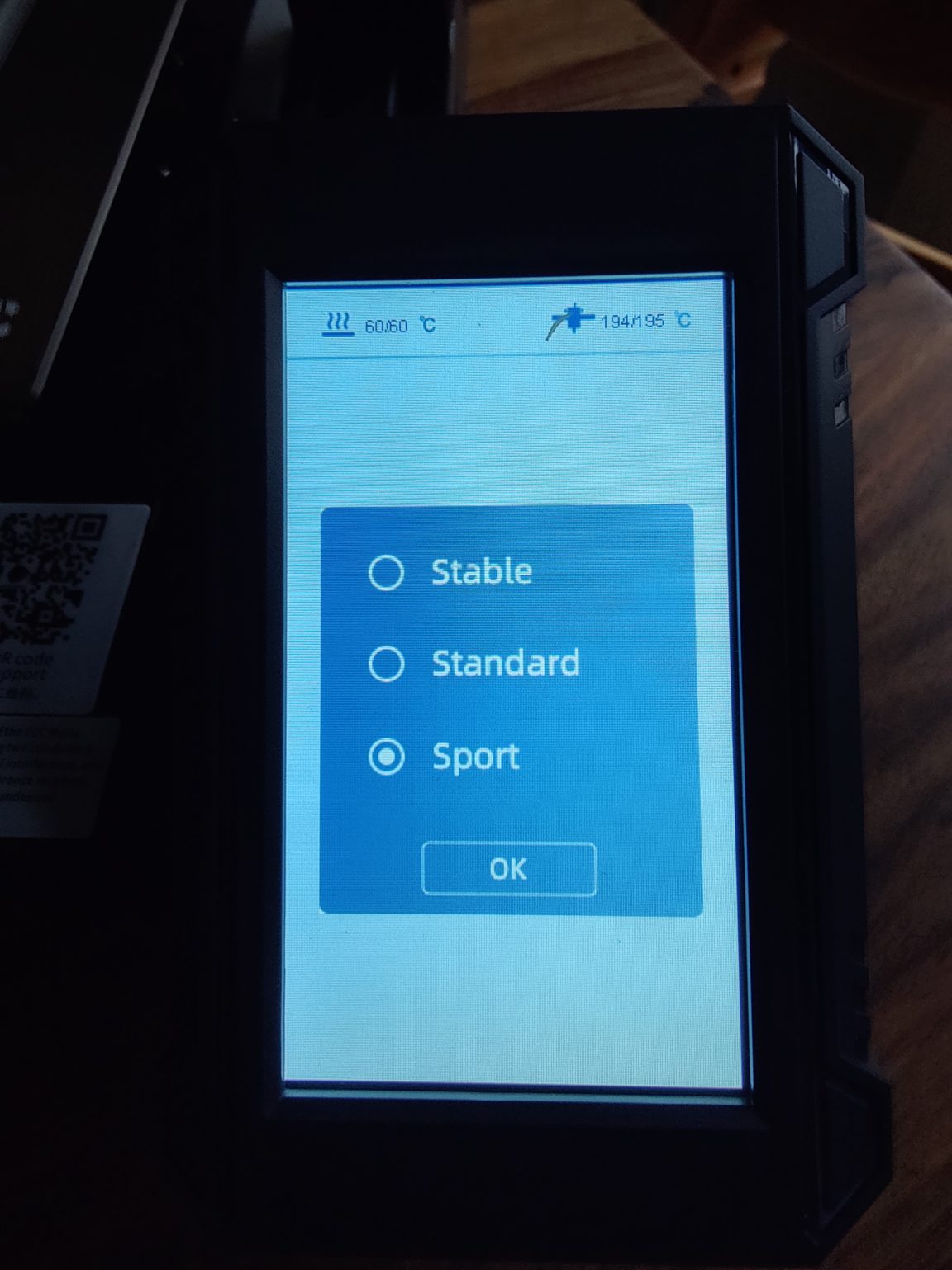
I check the eccentric screws on the print bed again. Everything runs smoothly, the print bed does not wobble in any direction. I want to use the sport mode again, this time with the iMakr Jenga block in CG orange (Bambu PLA), which is suitable for quick prints because of its simple geometry. In theory, the print bed does not have to move with large deflections. And indeed: This time there are no problems in Sport mode. At 120% speed, however, the print quality suffers significantly.
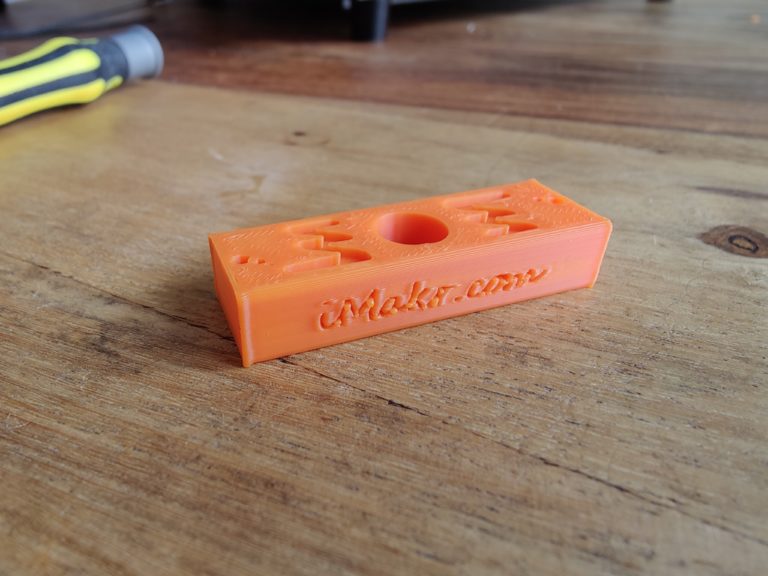
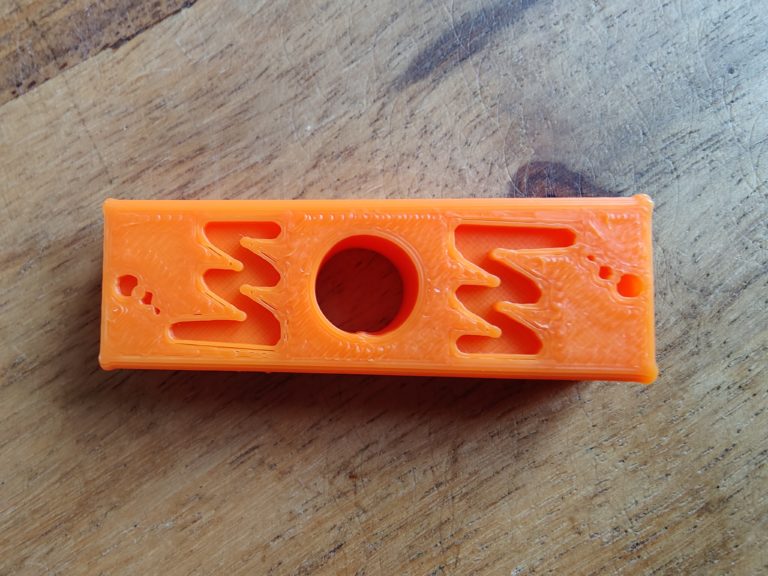
We will now print a fidget spinner in CG orange. But instead of the previous fidget spinner, we are now printing one with added value: the individual printed “bearings” have tolerances of 0.05 to 0.35 mm. If turning these bearings with your fingers is no longer possible, there is a screwdriver slot on the back of each one. The result shows that the bearings with 0.35 mm (middle) and 0.3 mm can be turned without a screwdriver. 0.25 and 0.2 can only be turned with a screwdriver.
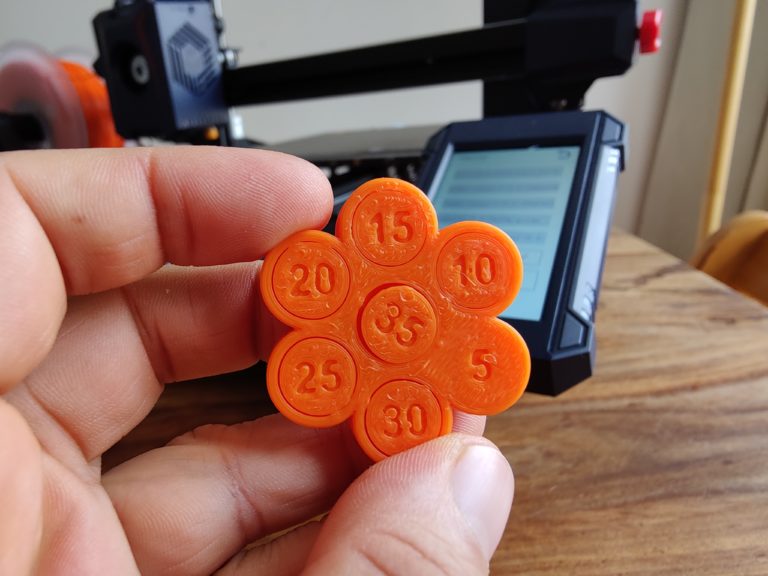
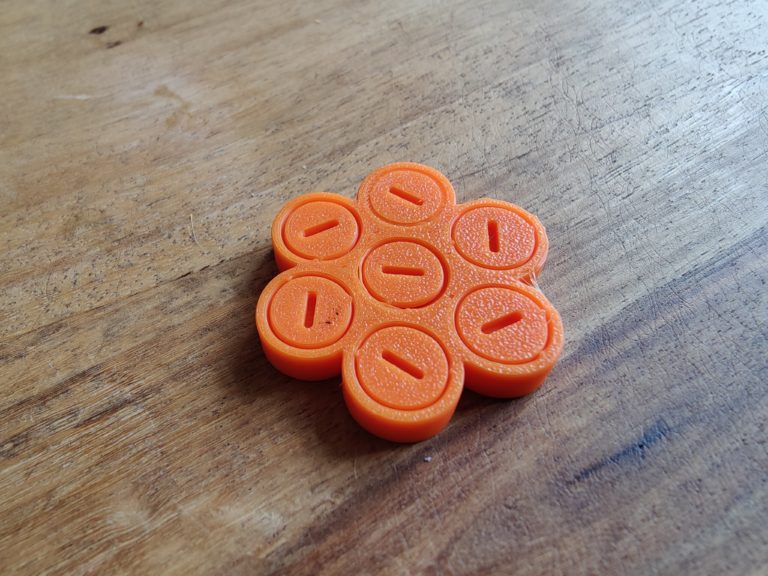
Conclusion: potential, but teething problems
The Anycubic Kobra 2 is a logical further development of the previous model. Even if it is advertised at 250mm/s, 150mm/s is recommended as the standard speed here at the current stage of development . In addition to the speed, Anycubic has a solid option for fully automatic leveling on board with the LeviQ 2.0, which still requires manual fine-tuning (Z-Offset). Once everything is set, the Kobra 2 prints loud but well – as long as you print at standard speed.
Anycubic has yet to get a grip on the problem with vibrations and creaking noises from the Y-axis motor . It would also be nice if the manufacturer put a little more love into the print profiles for PrusaSlicer and Cura. You have to live with a little ghosting because of Marlin Legacy. If you manage to implement these improvements, then the Kobra 2 can certainly become a well-rounded overall package at a reasonable price. What do you all mean? Would the Anycubic Kobra 2 be something for you?
Pros
- easy to set up & operate
- reliable direct extruder
- fully automatic auto-leveling
- good print quality at 150mm/s
Cons
- Engine problems (y-axis) in sport mode (status: 05/15/2023)
- manual setting of the Z offset necessary
- too loud
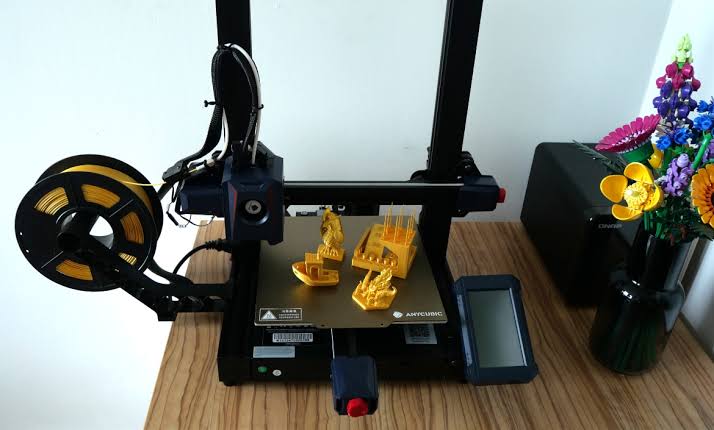
 Number One Boats from USA. Boat Marketplace Group Network. All Boats & Yachts for Sale, Reviews, Specs, Prices, Craigslists.
Number One Boats from USA. Boat Marketplace Group Network. All Boats & Yachts for Sale, Reviews, Specs, Prices, Craigslists. 